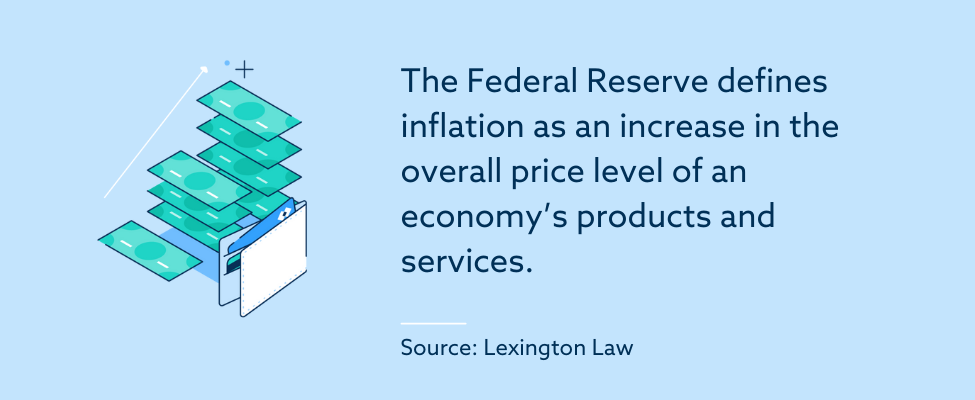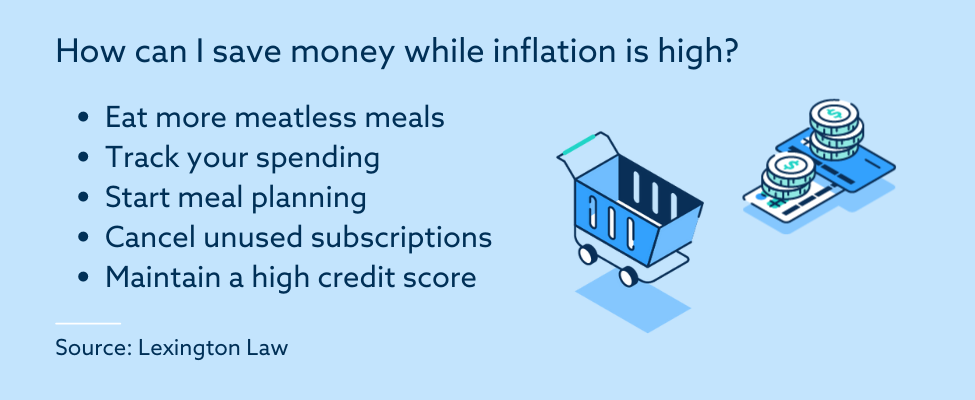
Government officials can’t predict exactly when inflation will go down, but representatives of the International Monetary Fund expect the U.S. inflation rate to reach its 2 percent target by the end of 2023.
The information provided on this website does not, and is not intended to, act as legal, financial or credit advice. See Lexington Law’s editorial disclosure for more information.
Consumers around the world are currently grappling with rising costs, making many people wonder how long this high rate of inflation is going to last. Although the U.S. inflation rate has nearly quadrupled since 2020, inflation is even worse in other countries. In Israel, for example, the inflation rate has increased by 25 times in the last two years.
When inflation is high, consumers have less purchasing power, making it more difficult to afford housing, food, utilities and other necessities. Some consumers have even changed their spending habits to account for rising costs. So, how long will inflation last? No one knows for sure, but it’s possible to make an educated guess based on what the Federal Reserve is currently doing to reduce spending.
What is inflation, and how does it work?
The Federal Reserve defines inflation as an increase in the overall price level of an economy’s products and services. This refers to a general increase in prices, not an increase in a single product or service category. For example, it’s possible for the cost of dairy products to increase without the rate of inflation increasing.
When inflation is high, many consumers have less purchasing power. This is because their income doesn’t buy as many products and services as it did when inflation was low. Inflation also has a negative impact on banks that loan money at fixed interest rates. If a bank makes a loan at 6 percent interest, an inflation rate of 7 percent would reduce its real income, or the amount of money it earns after taking inflation into account.
In the United States, the Consumer Price Index (CPI) helps estimate inflation by tracking the average change of prices over time. This index doesn’t include the price of every good or service. Instead, it uses a market basket of goods and services typically purchased by consumers in urban and metropolitan areas. In July 2022, the U.S. Bureau of Labor Statistics reported that the CPI rose by 1.3 percent in June, bringing the total increase for the last 12 months to 9.1 percent.

Why is inflation so high right now?
Although many Americans are feeling the pinch of higher prices, inflation is a global problem. In response to the COVID-19 pandemic, government officials around the world implemented mandatory lockdowns to prevent the spread of the disease. With so many businesses closed, the demand for goods and services declined.
Once businesses started reopening, demand soared. With the unemployment rate falling to 3.5 percent in July 2022, job seekers have more bargaining power, driving up wages and giving many consumers more money to spend on goods and services. Consumers also saved more money than usual in 2021 due to concerns over how the ongoing pandemic would affect their finances.
Although demand has increased, many companies are unable to fill orders due to manufacturing and shipping backlogs associated with the pandemic. When demand exceeds supply, firms increase their prices, contributing to higher rates of inflation.
Finally, many consumers are spending more on services than goods, increasing demand in the service sector. As a result, it now costs more to rent an apartment, dine at a restaurant or hire someone to perform housekeeping or landscaping services.
The government’s response to inflation
The Federal Reserve is currently implementing contractionary monetary policy to reduce demand and give the economy a chance to cool off. This involves raising interest rates to decrease consumer spending and business-related investment spending.
The Biden-Harris administration is also focused on lowering costs for low-income and middle-class families. President Biden signed the Inflation Reduction Act of 2022 into law on August 16, 2022, and this act aims to reduce energy costs and make healthcare more affordable for Americans.
Because the current inflation rate is associated with high levels of demand, there isn’t much more the federal government can do to bring prices down. The plan is to continue raising rates until the inflation rate returns to 2 percent.
When will inflation go down?
Government officials can’t predict exactly when inflation will go down, but representatives of the International Monetary Fund expect the U.S. inflation rate to reach its 2 percent target by the end of 2023. To reach this target, analysts believe the Federal Reserve will need to raise rates by another 2 to 2.5 percent before then.
Are we in a recession?
Although government officials, consumers and business owners are concerned about the prospect of a recession, the United States hasn’t entered a true recession yet. A recession is characterized by rising levels of unemployment, lower retail sales and negative growth of the gross domestic product (GDP), among other factors.
In July 2022, the Bureau of Economic Analysis reported that the U.S. GDP declined by 1.6 percent in the first quarter of the year and 0.9 percent in the second quarter. Although GDP declined, retail sales increased by 1 percent between May and June 2022. The unemployment rate also fell from 5.4 percent in July 2021 to 3.5 percent in 2022. Therefore, the United States doesn’t yet meet all the criteria for an economic recession.
Where is inflation the worst in the United States?
In the United States, cities tend to have higher inflation rates than suburbs and rural areas, due in part to their higher housing costs. On July 13, 2022, Bloomberg reported that several American cities had crossed the 10 percent mark. Urban Alaska is at 12.4 percent, the Phoenix-Mesa-Scottsdale metro area in Arizona is at 12.3 percent and the Atlanta-Sandy Springs-Roswell metro area in Georgia is at 11.5 percent. Baltimore, Seattle, Houston and Miami also have inflation rates above 10 percent.
Inflation isn’t quite as bad in the New York-Newark-Jersey City metropolitan area, which had a 6.7 percent inflation rate in June 2022. Overall, inflation tends to be higher in the South and Midwest regions than it is in the Northeast region of the United States.
How will inflation affect my 2022 and 2023 taxes?
Take a look at the top ways your upcoming taxes might be affected by inflation.
Taxable income
Federal tax brackets are adjusted for inflation, which means you may drop to a lower tax bracket in 2022 even if your income doesn’t decrease. If high rates of inflation persist, you may get the same tax benefit when you file your 2023 return.
The standard deduction is also adjusted for inflation, so high inflation rates may help you reduce your taxable income even more than in previous years. In 2021, the standard deduction for a single filer was $12,550; for the 2022 tax year, it’s $12,950. If the economy doesn’t cool down quickly, the standard deduction may be even higher in 2023.
Health savings accounts
The annual HSA contribution limit is adjusted for inflation, so high rates of inflation allow you to put aside more money for medical expenses each year. The limits have already been increased for 2022, allowing individuals to contribute $3,650 per year and families to contribute $7,300 per year. In 2023, the limits will increase even more, to $3,850 for individuals and $7,750 for families.
HSA contributions are deducted on a pre-tax basis, so higher contribution limits may leave you with less taxable income, reducing your tax burden.
Retirement contributions
High levels of inflation can even help you save a little more money for your retirement. The contribution limits for 401(k) accounts and individual retirement arrangements (IRAs) are adjusted for inflation, so you can typically save more when inflation is high. For 2022, the 401(k) contribution limit is $20,500, an increase from the $19,500 limit for 2021. The IRA contribution limit didn’t increase for 2022, but it may go up in 2023 if the inflation rate continues to be high.
Although you can’t save more in your IRA this year, the income limit for 2022 was increased to keep up with inflation. As a result, you can now participate in a Roth IRA if your income doesn’t exceed $144,000 ($214,000 for married couples filing jointly).
Social Security
If you have combined income of more than $25,000 in a year as a single filer, your Social Security benefits are subject to federal income taxes; the limit increases to $32,000 for married couples filing jointly. Combined income includes half your Social Security benefits, your adjusted gross income and your tax-exempt interest income. These income limits aren’t adjusted for inflation, but Social Security benefits are.
For 2022, the federal government implemented a 5.9 percent cost-of-living increase for Social Security beneficiaries, and the 2023 adjustment could be as high as 10 percent, or even slightly more—we’ll know for sure in October 2022. This increase could push your combined income above the $25,000/$32,000 limit, making your Social Security benefits taxable for the first time.
Capital gains taxes
When you sell certain assets, you must pay capital gains tax on your profit. If you sell when inflation is high, you could end up with a profit on paper even if the sale results in a real loss. This typically happens when high rates of inflation erode your purchasing power over time.
If you made a $100,000 investment in 1980 and sold it for $200,000 today, it would look like you made a profit of $100,000. The truth is that $100,000 in 1980 dollars is equivalent to about $359,600 today. Although you made a profit on paper, you really lost a significant amount of purchasing power. Unless you qualified for some type of exemption, you’d have to pay capital gains tax since the purchase price of assets isn’t adjusted for inflation.
How can I save money while inflation is high?
You can’t control the national economy, but there are a few things you can do to strengthen your financial position while inflation is high.
- Eat more meatless meals. Meat, poultry and eggs are among the food products with the highest price increases in 2022. To lessen the effects of rising costs on your budget, try adding a few meatless meals to your weekly menu.
- Track your spending. If you don’t keep track of your spending, it’s easy to spend much more than you realize. Keep a record of how much you spend on necessities as well as extras like streaming subscriptions and movie tickets.
- Start meal planning. If you spot a good deal at the grocery store, you can take advantage by planning several meals around that ingredient. For example, if a store is advertising chicken for $2.49 per pound, you may want to plan on eating chicken salad sandwiches for lunch each day that week.
- Cancel unused subscriptions: In June 2022, Sarah O’Brien of CNBC reported that more than 40 percent of consumers were paying for at least one subscription they didn’t use. Unused subscriptions leave you with less money in your pocket, so canceling them can help you weather this period of high inflation.
- Maintain a high credit score. When you have good credit, you typically qualify for lower interest rates and other favorable loan terms. If you have to borrow money while inflation is high, maintaining a healthy score can help you save money.

Keep the faith
Inflation makes it a little tougher to meet your financial goals, but that doesn’t mean you should give up on managing your finances responsibly. You can save money by tracking your spending, canceling unused subscriptions and planning your meals according to what foods are on sale each week.
Maintaining good credit can help you save money in the long run if you have to take out a loan or otherwise buy on credit. If your credit is lower than you’d like it to be, work with the credit repair consultants at Lexington Law to identify inaccurate negative items on your credit reports and make sure outdated information isn’t being held against you.
Note: Articles have only been reviewed by the indicated attorney, not written by them. The information provided on this website does not, and is not intended to, act as legal, financial or credit advice; instead, it is for general informational purposes only. Use of, and access to, this website or any of the links or resources contained within the site do not create an attorney-client or fiduciary relationship between the reader, user, or browser and website owner, authors, reviewers, contributors, contributing firms, or their respective agents or employers.
